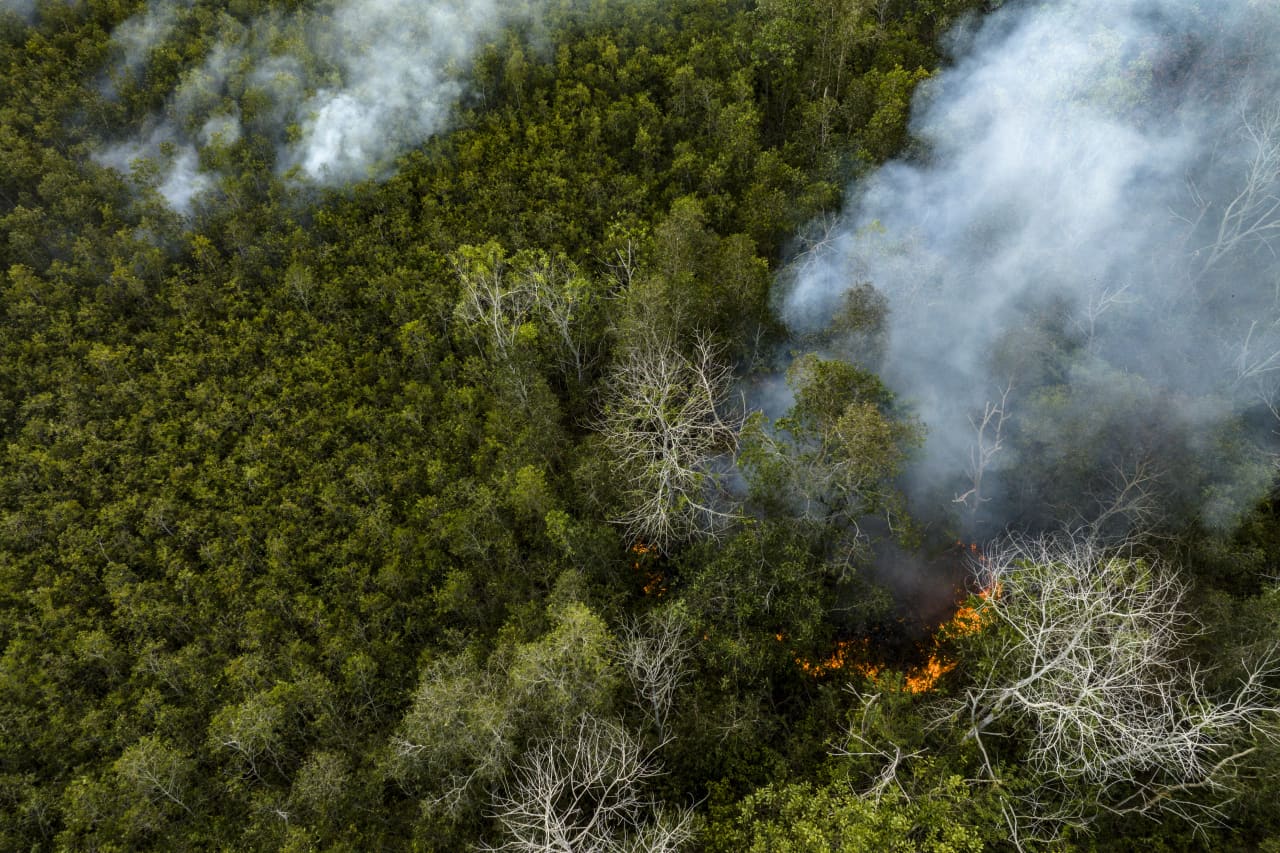Investing in nature to address climate change, support biodiversity, and protect ocean health—and more—is expected to reach record levels this year in response to more regulation and market demand, according to Cambridge Associates, a global investment firm.
Still, the amount of private capital invested to support natural systems will fall far short of what’s needed, according to the annual “State of Finance for Nature” report published in December from the United Nations Environment Programme.
A big reason is that nearly US$7 trillion in public and private finance was directed to companies and economic activities in 2022 that caused direct harm to nature, while only US$200 billion was directed to so-called nature-based solutions, or NbS—investments that protect, conserve, restore, or engage in the sustainable management of land and water ecosystems, as defined by the United National Environment Assembly 5, or UNEA5, the report said.
“Without a big turnaround on nature-negative finance flows, increased finance for NbS will have limited impact,” it said.
But the report also said that the misalignment “represents a massive opportunity to turn around private and public finance flows” to meet targets set by the United Nations Rio Conventions on climate change, desertification, and biodiversity loss.
The conventions aim to limit climate change to 1.5 degree Celsius above pre-industrial levels, protect 30% of the earth’s land and seas by 2030, and to reach “land degradation neutrality” by 2030. Reaching those goals will require more than double the amount of current levels of nature-based investing by 2025, to US$436 billion, and nearly triple today’s levels to US$542 billion by 2030, the report said.
Most of the US$200 billion invested in NbS today is by governments, but private investors contributed US$35 billion—including US$4.6 billion via impact investing funds and US$3.9 billion via philanthropy. The largest source of private finance was in the form of biodiversity offsets and credits. [An offset is designed to compensate for biodiversity loss, while a credit is the asset created to restore it].
Many wealthy individuals and families concerned about climate change and the environment so far have focused their investment dollars on climate solutions and innovations in technology and infrastructure, or in technologies supporting food and water efficiency, says Liqian Ma, head of sustainable investment at Cambridge Associates.
But “increasingly there is growing awareness that nature provides a lot of gifts and solutions if we prudently and responsibly manage nature-based assets,” Ma says.
Investments can be made, for instance, in sustainable forestry and sustainable agriculture—which can help sequester carbon—in addition to wetland mitigation, conservation, and ecosystem services.
“Those areas are not in the mainstream, but they are additional tools for investors,” Ma says.
Finance Earth, a London-based social enterprise, is among the organizations working to make these tools more mainstream by creating a wider array of nature-based solutions in addition to related investment vehicles.
Finance Earth groups nature-based solutions into six themes: agriculture, forestry, freshwater, marine/coastal, peatland, and species protection. Supporting many of these areas are an array of so-called ecosystem services, or benefits that nature provides such as absorbing carbon dioxide, boosting biodiversity, and providing nutrients, says Rich Fitton, director of Finance Earth.
Each of these ecosystem services are behind existing and emerging markets. Carbon-related disclosure requirements (at various stages of approval in the U.S. and elsewhere) have long spurred demand for carbon markets, the most mature of these markets.
Cambridge Associates, for instance, works with dedicated asset managers who have been approved by the California Air Resources Board to buy carbon credits, Ma says.
In its annual investment outlook, the firm said California’s carbon credits should outperform global stocks this year as the board is expected to reduce the supply of available credits to meet the state’s emission reduction targets. The value of these credits is expected to rise as the supply drops.
In September, the G20 Task Force on Nature-Related Financial Disclosures released recommendations (similar to those put forward several years ago by the Task Force for Carbon-related Financial Disclosure) that provide guidance for how companies can look across their supply chains to assess their impact on nature, water, and biodiversity “and then start to understand what the nature-related risks are for their business,” Fitton says.
The recommendations will continue to spur already thriving biodiversity markets, which exist in more than 100 countries including the U.S. In the U.K., a new rule called “Biodiversity Net Gain” went into effect this month requiring developers to produce a 10% net gain in biodiversity for every project they create.
Though developers can plant trees on land they’ve developed for housing, for example, they also will likely need to buy biodiversity credits from an environmental nonprofit or wildlife trust to replace and add to the biodiversity that was lost, Fitton says.
This new compliance market for biodiversity offsets could reach about £300 million (US$382 million) in size, he says.
Finance Earth and Federated Hermes are currently raising funds for a U.K. Nature Impact Fund that is likely to invest in those offsets in addition to other nature-based solutions, including voluntary offset markets for biodiverse woodlands and for peatlands restoration.
The fund was seeded with £30 million from the U.K. Department for Environment, Food and Rural Affairs—money that is designed to absorb first losses, should that be needed. The government investment gives mainstream investors more security to step into a relatively new sector, Fitton says.
“We need the public sector and philanthropy to take a bit more downside risk,” he says. That way Finance Earth can tell mainstream investors “look, I know you haven’t invested in nature directly before, but we are pretty confident we’ve got commercial-level returns we can generate, and we’ve got this public sector [entity] who’s endorsing the fund and taking more risk,” Fitton says.
Since December 2022, when 188 government representatives attending the UN Biodiversity Conference in Montreal agreed to address biodiversity loss, restore ecosystems, and protect indigenous rights, several asset managers began “creating new strategies or refining strategies to be more nature or biodiversity focused,” Ma says.
He cautioned, however, that some asset managers are more authentic about it than others.
“Some have taken it seriously to hire scientists to do this properly and make sure that it’s not just a greenwashing or impact-washing exercise,” Ma says. “We’re starting to see some of those strategies come to market and, in terms of actual decisions and deployments, that’s why we think this year we’ll see a boost.”
Fitton has noticed, too, that institutional investors are hiring experts in natural capital, recognizing that it’s a separate asset class that requires expertise.
“When that starts happening across the board then meaningful amounts of money will move,” he says. “There’s lots of projects there, there’s lots of things to invest in and there’ll be more and more projects to invest in as more of these markets become more and more mature.”
 Copyright 2020, Dow Jones & Company, Inc. All Rights Reserved Worldwide. LEARN MORE
Copyright 2020, Dow Jones & Company, Inc. All Rights Reserved Worldwide. LEARN MORE
What a quarter-million dollars gets you in the western capital.
Alexandre de Betak and his wife are focusing on their most personal project yet.
As Paris makes its final preparations for the Olympic games, its residents are busy with their own—packing their suitcases, confirming their reservations, and getting out of town.
Worried about the hordes of crowds and overall chaos the Olympics could bring, Parisians are fleeing the city in droves and inundating resort cities around the country. Hotels and holiday rentals in some of France’s most popular vacation destinations—from the French Riviera in the south to the beaches of Normandy in the north—say they are expecting massive crowds this year in advance of the Olympics. The games will run from July 26-Aug. 1.
“It’s already a major holiday season for us, and beyond that, we have the Olympics,” says Stéphane Personeni, general manager of the Lily of the Valley hotel in Saint Tropez. “People began booking early this year.”
Personeni’s hotel typically has no issues filling its rooms each summer—by May of each year, the luxury hotel typically finds itself completely booked out for the months of July and August. But this year, the 53-room hotel began filling up for summer reservations in February.
“We told our regular guests that everything—hotels, apartments, villas—are going to be hard to find this summer,” Personeni says. His neighbours around Saint Tropez say they’re similarly booked up.
As of March, the online marketplace Gens de Confiance (“Trusted People”), saw a 50% increase in reservations from Parisians seeking vacation rentals outside the capital during the Olympics.
Already, August is a popular vacation time for the French. With a minimum of five weeks of vacation mandated by law, many decide to take the entire month off, renting out villas in beachside destinations for longer periods.
But beyond the typical August travel, the Olympics are having a real impact, says Bertille Marchal, a spokesperson for Gens de Confiance.
“We’ve seen nearly three times more reservations for the dates of the Olympics than the following two weeks,” Marchal says. “The increase is definitely linked to the Olympic Games.”

Getty Images
According to the site, the most sought-out vacation destinations are Morbihan and Loire-Atlantique, a seaside region in the northwest; le Var, a coastal area within the southeast of France along the Côte d’Azur; and the island of Corsica in the Mediterranean.
Meanwhile, the Olympics haven’t necessarily been a boon to foreign tourism in the country. Many tourists who might have otherwise come to France are avoiding it this year in favour of other European capitals. In Paris, demand for stays at high-end hotels has collapsed, with bookings down 50% in July compared to last year, according to UMIH Prestige, which represents hotels charging at least €800 ($865) a night for rooms.
Earlier this year, high-end restaurants and concierges said the Olympics might even be an opportunity to score a hard-get-seat at the city’s fine dining.
In the Occitanie region in southwest France, the overall number of reservations this summer hasn’t changed much from last year, says Vincent Gare, president of the regional tourism committee there.
“But looking further at the numbers, we do see an increase in the clientele coming from the Paris region,” Gare told Le Figaro, noting that the increase in reservations has fallen directly on the dates of the Olympic games.
Michel Barré, a retiree living in Paris’s Le Marais neighbourhood, is one of those opting for the beach rather than the opening ceremony. In January, he booked a stay in Normandy for two weeks.
“Even though it’s a major European capital, Paris is still a small city—it’s a massive effort to host all of these events,” Barré says. “The Olympics are going to be a mess.”
More than anything, he just wants some calm after an event-filled summer in Paris, which just before the Olympics experienced the drama of a snap election called by Macron.
“It’s been a hectic summer here,” he says.

AFP via Getty Images
Parisians—Barré included—feel that the city, by over-catering to its tourists, is driving out many residents.
Parts of the Seine—usually one of the most popular summertime hangout spots —have been closed off for weeks as the city installs bleachers and Olympics signage. In certain neighbourhoods, residents will need to scan a QR code with police to access their own apartments. And from the Olympics to Sept. 8, Paris is nearly doubling the price of transit tickets from €2.15 to €4 per ride.
The city’s clear willingness to capitalise on its tourists has motivated some residents to do the same. In March, the number of active Airbnb listings in Paris reached an all-time high as hosts rushed to list their apartments. Listings grew 40% from the same time last year, according to the company.
With their regular clients taking off, Parisian restaurants and merchants are complaining that business is down.
“Are there any Parisians left in Paris?” Alaine Fontaine, president of the restaurant industry association, told the radio station Franceinfo on Sunday. “For the last three weeks, there haven’t been any here.”
Still, for all the talk of those leaving, there are plenty who have decided to stick around.
Jay Swanson, an American expat and YouTuber, can’t imagine leaving during the Olympics—he secured his tickets to see ping pong and volleyball last year. He’s also less concerned about the crowds and road closures than others, having just put together a series of videos explaining how to navigate Paris during the games.
“It’s been 100 years since the Games came to Paris; when else will we get a chance to host the world like this?” Swanson says. “So many Parisians are leaving and tourism is down, so not only will it be quiet but the only people left will be here for a party.”















